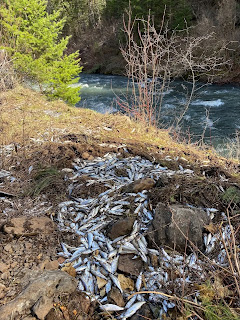A hatchery tanker caring thousands of young salmons an smolts crashed on a sharp curve when its driver lost control last Friday near Elgin, OR. Loaded with fish and water the tanker weighed 80,000 pounds. Fortunately for the salmon, Lookingglass Creek was next to the road. The 26,000 smolts died, but the young salmon managed to swim into the creek and survive. The 100,000 fish were supposed to restock the Imnaha River. A fisheries spokesperson said that the salmon are now expected to reach the sea via the Grand Ronde River. The incident reminds US how resilient nature is, and especially salmon.
Employees of the Union County Sheriffs Office and Nez Pierce tribe members cleaned up the spill and counted the fish. The smolts were too young to flop into the water; 77,000 salmon did reach the creek The state of Oregon spends considerable amounts on hatching salmon to repopulate depleted rivers and streams. The Lookingglass Creek hatchery is one of thirty-three operated by the state.The dams on the lower Snake River seem to be a major choke point for migrating salmon. It seems to US Person that money could be more effectively spent on removing unneeded dams, restoring riverine habitat and reducing pollution. This story reminds US Person of the time he assisted a spawning Chinook salmon over a weir in Alaska to reach his home lake.
Salmon spend about three years at sea foraging and building strength for the return journey to their spawning grounds. Smolts are around eighteen months old; they conserve their stregth by floating tail first on the spring run-off 650 miles to the Pacific Ocean. Scientists think that salmon use their sense of smell to navigate their return. [photo credit: USFWS]
In Iowa, the Nishnabotna River was the scene of an another devastation of aquatic life last month. An open valve on a storage tank allowed 265,000 gallons of liquid nitrogen to leak into the river. The toxic chemical soon spread to the Missouri River. An estimated 790,000 fish died in a stretch of rivers 60 miles long. Carcasses lined the banks of the Nishnabotna. The dead were mostly smaller species, but large catfish and shovel nose sturgeon also perished. The spill was the most deadly since 2023 when run-off from a dairy farm killed 800,000. Iowa has struggled with controlling agricultural contamination of its rivers and streams. Despite advocacy from environmentalists, no regulatory legislation has passed the Repugnant-controlled legislature.
